

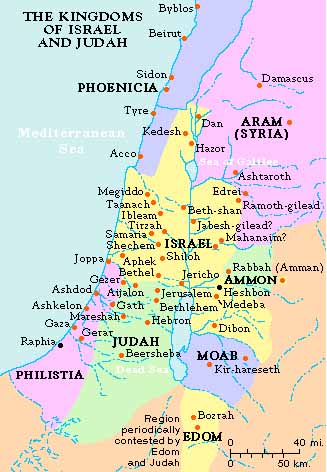
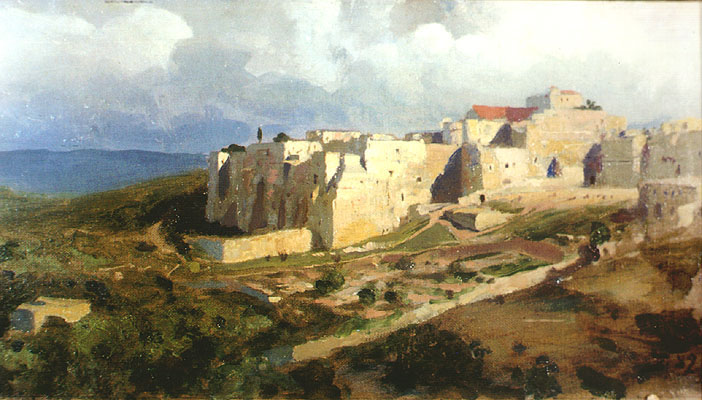
Bethlehem (House of Bread - House of Lahmu) is is a Palestinian city in the West Bank and a hub of Palestinian cultural and tourism industries. It is first mentioned in the Armana letters fourteen centuries BCE. It lies about 10 km (6 mi) south of Jerusalem, standing at an elevation of about 765 m (2 510 ft) above the sea, thus 30 m (100 ft) higher than Jerusalem. The Bethlehem agglomeration also covers the small towns of Beit Jala and Beit Sahour, the latter also having biblical significance.
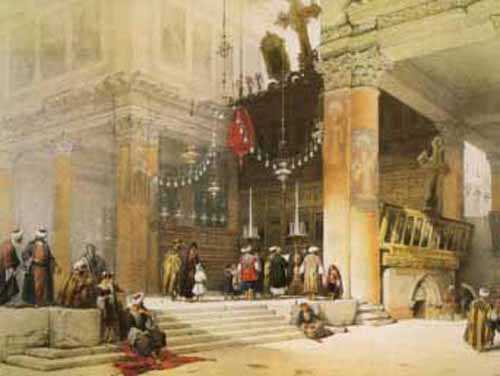
The city has great significance to the Christian religion as it is believed to be the birthplace of Jesus of Nazareth. The traditional site of Rachel's tomb, which is important in Judaism, lies at the city's outskirts. Bethlehem is also home to one of largest Palestinian Christian communities in the Middle East.
Bethlehem plays a significant part in the Old Testament, in the history of the Israelites, both before they entered Egypt and slavery, and after the Exodus. It appears in the Old Testament as Ephrat, where Rachel the beloved matriarch of the Jewish People, the favorite wife of Jacob, died during childbirth.
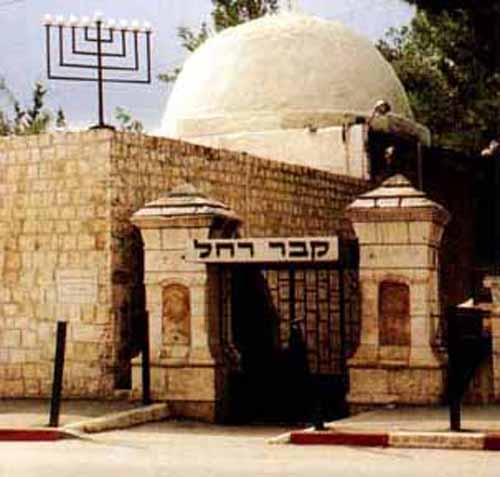
Rachel's Tomb
The Tomb of Rachel, is a pilgrimage place for Jews and Muslims alike. Among other Biblical mentions and Holy Sites in Bethlehem: Rachel's tomb, Naomi and Ruth, Samuel anoints King David and the well from which David's warriors brought him waters.
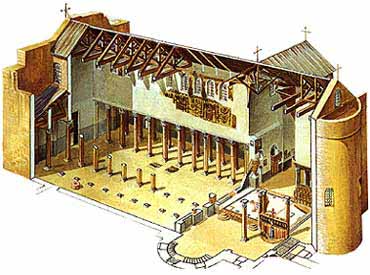
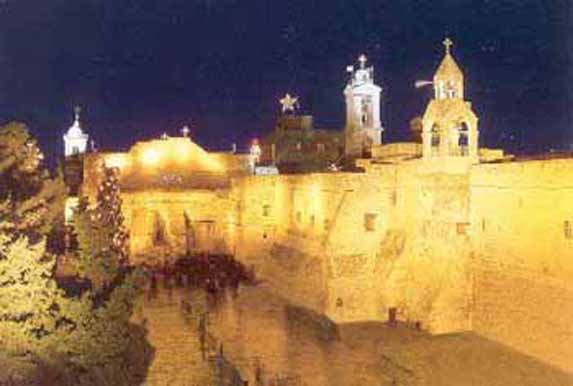
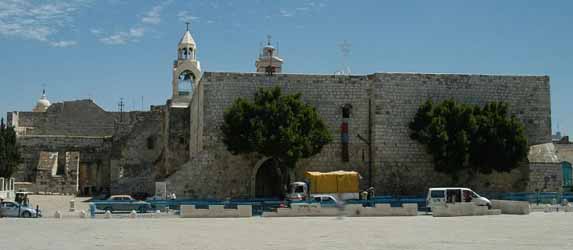
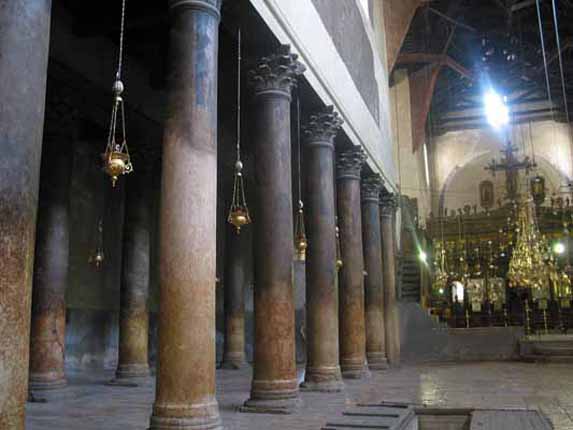
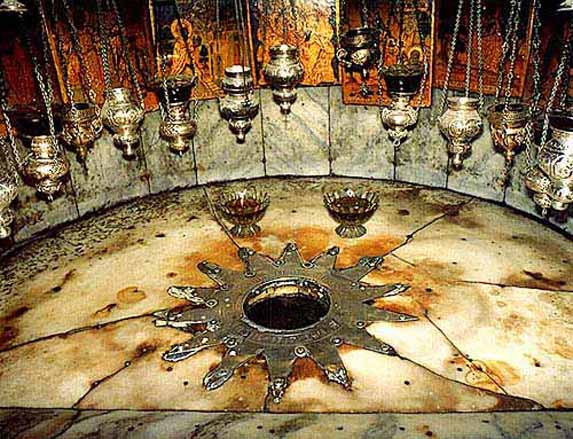
Silver star marking the place where Jesus was born according to Christian tradition
The Manger is situated on the north side of the Grotto, and opposite the Manger, an Alter is dedicated to the Wise Men who came to Bethlehem from the East under the guidance of a star bearing gifts to Baby Jesus.
The original structure was built by Bishop Makarios of Jerusalem at the direction of Constantine I of the Roman Empire following the First Council of Nicaea in 325. That structure was burned down in the Samaritan revolt of 529. It is administered by a coalition of Roman Catholic and Greek Orthodox clerics. Tradition has it that the church was built over Jesus' birthplace, and it is held as sacred by followers of Christianity and Islam.
It is actually a combination of two churches, with a crypt, the Grotto of the Nativity, where Jesus is said to have been born:

Today, the vast tracts of pasture land are roamed by flocks of sheep and goats, led by shepherds who wear, now as in the past, severe dark robes and their typical headdress. Against this backdrop events transpired which are recorded in the Scriptures, both Jewish and Christian. The pastures known as the 'Shepherds' Fields' witnessed lives of ancestors of David, the great king of the Jews; and they also witnessed and Angel's Annunciation of the birth of the Son of God to the Shepherds.
The first historical reference to the town appears in the Amarna Letters (c. 1400 BC) when the King of Jerusalem appeals to his overlord, the King of Egypt, for help in retaking "Bit-Lahmi" in the wake of disturbances by the Apiru. It is thought that the similarity of this name to its modern forms indicates that this was a settlement of Canaanites who shared a Semitic cultural and linguistic heritage with the later arrivals.
Lachmo was the Akkadian god of fertility. Worshiped by the Canaanites as Lachama, some time in the 3rd millennium BC, they erected a temple to worship the god on the hill now known as the Hill of the Nativity. The town was known as Beit Lachama, meaning "House of Lachama." William F. Albright notes the pronunciation of the name remained essentially the same for 3,500 years, but has meant different things: "'Temple of the God Lakhmu' in Canaanite, 'House of Bread' in Hebrew and Aramaic, 'House of Flesh' in Arabic."
Biblical scholars believe Bethlehem, located in the "hill country" of Judah, may be the same as the Biblical Ephrath, which means "fertile", as there is a reference to it in the Book of Micah as Bethlehem Ephratah. The Bible also calls it Beth-Lehem Judah, and "a city of David". It is first mentioned in the Tanakh and the Bible as the place where the matriarch Rachel died and was buried "by the wayside" (Gen. 48:7).
Rachel's Tomb, the traditional grave site, stands at the entrance to Bethlehem. According to the Book of Ruth, the valley to the east is where Ruth of Moab gleaned the fields and returned to town with Naomi. Biblical tradition holds that Bethlehem is the birthplace of David, the second king of Israel, and the place where he was anointed king by Samuel. It was from the well of Bethlehem that three of his warriors brought him water when he was hiding in the cave of Adullam.
Between 132Đ135 the city was reoccupied by the Romans after its capture during the Bar Kokhba Revolt. Its Jewish residents were expelled by the military order of Hadrian. The Romans built a shrine to the mythical Greek cult figure Adonis on the site of the Nativity.A church was erected in 326, when Helena, the mother of the first Byzantine emperor Constantine, visited Bethlehem.
During the Samaritan revolt of 529, Bethlehem was sacked and its walls and the Church of the Nativity destroyed, but they were rebuilt on the orders of the Emperor Justinian I. In 614, the Persian Sassanid Empire, supported be Jewish rebels, invaded Palestina Prima and captured Bethlehem. A story recounted in later sources holds that they refrained from destroying the church on seeing the magi depicted in Persian clothing in a mosaic.
The city was wrecked during Bar Kokhba's revolt (132-135 AD) and the Romans set up a shrine to Adonis on the site of the Nativity. Only in 326 was the first Christian church constructed, when Helena, the mother of the first Christian emperor, Constantine, visited Bethlehem. During the Samaritan revolt of 529, Bethlehem was sacked and its walls and the Church of the Nativity destroyed, but they were soon rebuilt on the orders of the Emperor Justinian. In 614, the Persians invaded Palestine and captured Bethlehem. A story recounted in later sources holds that they refrained from destroying the Church of the Nativity on seeing the magi depicted in Persian clothing in one of the mosaics.
In 637, shortly after Jerusalem was captured by the Muslim armies, the Caliph Umar ibn al-Khattab visited Bethlehem and promised that the Church of the Nativity would be preserved for Christian use.
In 1099, Bethlehem was captured by the Crusaders, who fortified it and built a new monastery and cloister on the north side of the Church of the Nativity. The town prospered under their rule. On Christmas Day 1100 Baldwin I, first king of the Frankish Kingdom of Jerusalem, was crowned in Bethlehem, and that year a Latin episcopate was also established in the town.
In 1187, Saladin captured Bethlehem from the Crusaders, and the Latin clerics were forced to leave. Saladin agreed to the return of two Latin priests and two deacons in 1192. However, the town suffered from the loss of the pilgrim trade. Bethlehem was briefly returned to Crusader control by treaty between 1229 and 1244.
In 1250, with the coming to power of Rukn al-Din Baibars, tolerance of Christianity declined, clergy left the town, and in 1263 the walls of the town were demolished.
The Latin clergy returned to the town over the following century, establishing themselves in the monastery adjoining the Basilica, and in 1347 the Franciscans gained possession of the Grotto of the Nativity as well as the right to administer and maintain the Basilica.
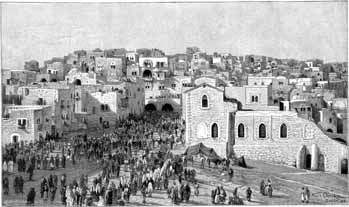
From 1517, during the years of Ottoman control, custody of the Basilica was bitterly disputed between the Catholic and Greek Orthodox churches. By the end of the 16th century, Bethelem had become one of the largest villages in the District of Jerusalem, and was subdivided into seven quarters. The Basbus family served as the heads of Bethlehem among other leaders during this period.
Bethlehem paid taxes on wheat, barley, and grapes. The Muslims and Christians were organized into separate communities, each having its own leader; five leaders represented the village in the mid-16th century, three of whom were Muslims. Ottoman tax records suggest that the Christian population was slightly more prosperous or grew more grain as opposed to grapes, the former being a more valuable commodity.
From 1831 to 1841, Palestine was under the rule Muhammad Ali Dynasty of Egypt. During this period, the town suffered an earthquake as well as the destruction of the Muslim quarter in 1834 by Egyptian troops, apparently as a reprisal for the murder of a favored loyalist of Ibrahim Pasha.
In 1841, Bethlehem came under Ottoman rule once more and remained so until the end of World War I. Under the Ottomans, Bethlehem's inhabitants faced unemployment, compulsory military service and heavy taxes, resulting in mass emigration particularly to South America.
An American missionary in the 1850s reports a population of under 4,000, 'nearly all of them belong to the Greek Church.' He also comments that 'there is a fatal lack of water' and hence it could never become a large town.
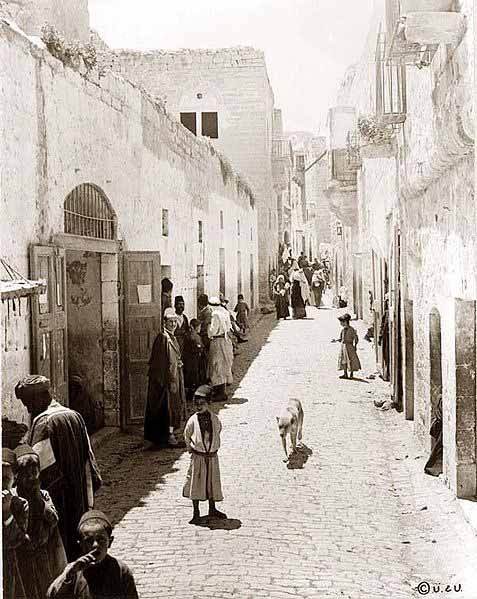
Bethlehem 1880
Bethlehem was administered by the British Mandate from 1920 until 1948. In the United Nations General Assembly's 1947 resolution to partition Palestine, Bethlehem was included in the special international enclave of Jerusalem to be administered by the United Nations.
Jordan annexed the city during the 1948 Arab-Israeli War. Many refugees from areas captured by Israeli forces in 1947-48 fled to the Bethlehem area, primarily settling in the what became the official refugee camps of 'Azza (Beit Jibrin) and 'Aida in the north and Dheisheh in the south. The influx of refugees significantly transformed Bethlehem's Christian majority into a Muslim one.
Jordan retained control of the city until the Six-Day War in 1967, when Bethlehem was occupied by Israel, along with the rest of the West Bank.
In the 1947 resolution by the United Nations General Assembly to partition Palestine, Bethlehem was included in the special international enclave of Jerusalem to be administered by the United Nations. Jordan occupied the city during the 1948 Arab-Israeli War. Many refugees from areas captured by Zionist forces in 1947 - 1948 came to Bethlehem, setting up encampments in the north of the city near the road to Jerusalem and on the hillside to the south between the city and Solomon's Pools. These later became the official refugee camps of Beit Jibrin (or al-'Azza) and 'A'ida (in the north) and Deheisheh in the south. This influx of refugees changed the demography of Bethlehem considerably.
Jordan retained control of the city until the Six-Day War in 1967, when Bethlehem was occupied by Israel, along with the rest of the West Bank.
Following the Six-Day War, Israeli took control of the city, and held it until the Oslo peace accords allowed its transition to the Palestinian National Authority in 1995.
On December 21, 1995, Israeli troops withdrew from Bethlehem, and three days later the city came under the complete administration and military control of the Palestinian National Authority in conformance with the Interim Agreement on the West Bank and the Gaza Strip in 1995.
During the Second Palestinian Intifada, in 2000-01, Bethlehem's infrastructure and tourism industry were severely damaged.
In 2002, it was a primary combat zone in Operation Defensive Shield, a major military offensive by the Israeli Defense Forces (IDF). During the operation, the IDF besieged the Church of the Nativity, where about 200 Palestinian militants sought refuge in the Church. The siege lasted for 39 days and nine militants and the church's bell-ringer were killed. It ended with an agreement to exile 13 of the wanted militants to various European nations and Mauritania. [edit]
Church of the Nativity Siege
With the escalation of the Israeli-Palestinian conflict, Bethlehem has been the site of many confrontations. In May 2002, during an Israel Defense Forces raid into the city, a number of locals (some of whom were armed) fled into the Church of the Nativity. According to senior Tanzim commander Abdullah Abu-Hadid, the church was specifically chosen due to its abundant supplies of food, water, and as a focal point for international outcry.
It became the site of a 5-week stand-off. The number of people inside was estimated between 120 and 240 hostages forbidden to leave the site by at least 40 gunmen. Several groups of civilians were allowed out of the church during the 5 week siege. During the siege several Palestinians inside the church compound were shot dead by Israeli snipers. The siege ended with an agreement for 13 militants to be sent via Cyprus to various European counties and another 26 to be sent to Gaza. The rest were set free. The IDF stated that 40 explosive devices were found and removed from the compound after the standoff was concluded.
Bethlehem, Beit Sahour and Beit Jala are currently surrounded by Israeli checkpoints and roadblocks, with the main road to Jerusalem cut off at the burder of Jerusalem's municipal area - at Rachel's Tomb. Bethlehem residents are only allowed into Jerusalem (the main social, economic and religious centre of the region) with special permits that are usually refused. Travel to other parts of the Palestinian controlled territories of the West Bank is also impeded and sometimes prevented. The city has periodically been placed under strict curfew, preventing residents from leaving their homes. Palestinians are not allowed to enter the Jewish holy site of Rachel's Tomb, which is on the outskirts of the city. Since Bethlehem and the nearby biblical Solomon's Pools lie in Area A, Israeli citizens cannot go there without a permit from the Israeli military authorities.
The construction by Israel of the West Bank barrier has had a severe impact on Bethlehem. The barrier runs along the northern side of the town's built-up area, within metres of houses in 'A'ida refugee camp and the Jerusalem municipality.
Demographic change - Bethlehem's former mayor, Hanna Nasser, says an estimated 2,000 Christians in Bethlehem have emigrated during the period of 2000 - 2003. Fifty years ago, Bethlehem was overwhelmingly Christian. Today, it has a Muslim majority.
Some researchers believe that the New Testament is mistaken on the location of Jesus' birth, and claim that the true birthplace was Bethlehem in the Galilee. The site featured the ruins of a church and a synagogue until the late 19th century, and was found to have archeological evidence of a prosperous city; many scholars place Beth Lehem of Galilee as one of the birth places of Rabbinical Judaism - it is by all accounts a logical place for a spiritual leader with a small group of followers to develop his doctrines. The distance from Nazareth also settles the problem of Jesus crossing the distance between the two cities in six hours according to the New Testament.
Israeli archeologist Aviram Oshri of the Israel Antiquity Authority, who has excavated and mapped the site, found solid evidence of a flourishing Jewish community at the site well before the year 1, and a wall built around the settlement later (though neighbouring Jewish towns never built one). To some archeologists this is a sign of a separatist cult community of some sort, which probably feared the religious wrath of their neighbors rather than more enemies.
In comparison, the Bethlehem area south of Jerusalem has never produced any archeological evidence of a town existing in about 1 AD, until the first Byzantine town in that area some time in the 3rd century. The Judean Bethlehem location was the preferred mythical birthplace of Christ, backing up his lineage to King David.
Bethlehem stands at an elevation of about 775 meters (2,543 ft) above sea level, 30 meters (98 ft) higher than nearby Jerusalem. Bethlehem is situated on the southern portion in the Judean Mountains. The city is located 73 kilometers (45 mi) northeast of Gaza and the Mediterranean Sea, 75 kilometers (47 mi) west of Amman, Jordan, 59 kilometers (37 mi) southeast of Tel Aviv, Israel and 10 kilometers (6.2 mi) south of Jerusalem. Nearby cities and towns include Beit Safafa and Jerusalem to the north, Beit Jala to the northwest, Husan to the west, al-Khadr and Artas to the southwest, and Beit Sahour to the east. Beit Jala and the latter form an agglomeration with Bethlehem and the Aida and Azza refugee camps are located within the city limits.
In the center of Bethlehem is its old city. The old city consists of eight quarters, laid out in a mosaic style, forming the area around the Manger Square. The quarters include the Christian al-Najajreh, al-Farahiyeh, al-Anatreh, al-Tarajmeh, al-Qawawsa and Hreizat quarters and al-Fawaghreh - the only Muslim quarter. Most of the Christian quarters are named after the Arab Ghassanid clans that settled there. Al-Qawawsa Quarter was formed by Arab Christian emigrants from the nearby town of Tuqu' in the 18th century. There is also a Syriac quarter outside of the old city, whose inhabitants originate from Midyat and Ma'asarte in Turkey. The total population of the old city is about 5,000.
Bethlehem has a Mediterranean climate, with hot and dry summers and cold winters. Winter temperatures (mid-December to mid-March) can be cold and rainy. January is the coldest month, with temperatures ranging from 1 to 13 degree Celsius (33Đ55 degrees F). From May through September, the weather is warm and sunny. August is the hottest month, with a high of 27 degrees Celsius (81 degrees F. Bethlehem receives an average of 700 millimeters (28 in) of rainfall annually, 70% between November and January.
Bethlehem's average annual relative humidity is 60% and reaches its highest rates between January and February. Humidity levels are at their lowest in May. Night dew may occur in up to 180 days per year. The city is influenced by the Mediterranean Sea breeze that occurs around mid-day. However, Bethlehem is affected also by annual waves of hot, dry, sandy and dust Khamaseen winds from the Arabian Desert, during April, May and mid-June.
According to Ottoman tax records, Christians made up roughly 60% of the population in the early 16th century, while the Christian and Muslim population became equal in the mid-16th century. There were no Muslim inhabitants by the end of the century, with a recorded population of 287 adult male tax-payers. Christians, like all non-Muslims throughout the Ottoman Empire, were required to pay the jizya tax.
In 1867 an American visitor describes the town as having a population of 3,000 to 4,000; of whom about 100 were Protestants, 300 were Muslims and "the remainder belonging to the Latin and Greek Churches with a few Armenians". Another report from the same year puts the Christian population at 3,000, with an additional 50 Muslims.
In 1948, the religious makeup of the city was 85% Christian, mostly of the Greek Orthodox and Roman Catholic denominations, and 13% Sunni Muslim.
In the 1967 census taken by Israel authorities, the town of Bethlehem proper numbered 14,439 inhabitants, its 7,790 Muslim inhabitants represented 53.9% of the population, while the Christians of various denominations numbered 6,231 or 46.1%.
In the PCBS's 1997 census, the city had a population of 21,670, including a total of 6,570 refugees, accounting for 30.3% of the city's population.
In 1997, the age distribution of Bethlehem's inhabitants was 27.4% under the age of 10, 20% from 10 to 19, 17.3% from 20-29, 17.7% from 30 to 44, 12.1% from 45-64 and 5.3% above the age of 65. There were 11,079 males and 10,594 females.
According to a PCBS estimate, Bethlehem's population was 29,930 in mid 2006. The 2007 PCBS census, however, revealed a population of 25,266, of which 12,753 were males and 12,513 were females. There were 6,709 housing units, of which 5,211 were households. The average household consisted of 4.8 family members.
By 2005, the proportion of Christian residents had decreased dramatically, to about 40% from 50%. The only mosque in the Old City is the Mosque of Omar, located in the Manger Square.
-
Many of Bethlehem's Christian inhabitants claim ancestry from Arab Christian clans from the Arabian Peninsula, including the city's two largest: al-Farahiyya and an-Najajreh. The former claims to have descended from the Ghassanids who migrated from Yemen to the Wadi Musa area in present-day Jordan and an-Najajreh descend from the Arabs of Najran in the southern Hejaz. Another Bethlehem clan, al-Anantreh, also trace their ancestry to the Arabian Peninsula.
The percentage of Christians in the town has been steadily falling, primarily due to emigration. The lower birth rate of Christians also accounts for some of the decline. In 1947, Christians made up 85% of the population, but by 1998 the figure had declined to 40%.
In 2005, the mayor of Bethlehem, Victor Batarseh explained that "due to the stress, either physical or psychological, and the bad economic situation, many people are emigrating, either Christians or Muslims, but it is more apparent among Christians, because they already are a minority."The Palestinian Authority is officially committed to equality for Christians, although there have been incidents of violence against them by the Preventive Security Service and militant factions.
The outbreak of the Second Intifada and the resultant decrease in tourism also affected the Christian minority, as they are the owners of many Bethlehem hotels and services that cater to foreign tourists. A statistical analysis of the Christian exodus cited lack of economic and educational opportunity, especially due to the Christians' middle-class status and higher education. Since the Second Intifada, 10% of the Christian population have left the city.
In 2006, the Palestinian Centre for Research and Cultural Dialogue conducted a poll among the city's Christians according to which 90% said they had had Muslim friends, 73.3% agreed that the PNA treated Christian heritage in the city with respect and 78% attributed the exodus of Christians to the Israeli travel restrictions.
Two accounts in the New Testament describe Jesus as being born in Bethlehem. According to the Gospel of Luke,Jesus' parents lived in Nazareth and travelled for the Census of Quirinius to Bethlehem, where Jesus was born, after which they returned home.
The Gospel of Matthew accounts that Jesus was born in Bethlehem and fled later to Nazareth to escape persecution. Matthew says that Herod the Great, told that a 'King of the Jews' has been born in Bethlehem, ordered the killing of all the children aged two and under in the town and surrounding areas. Joseph is warned of this in a dream, and the family escapes this fate by fleeing to Egypt and returning only after Herod has died. Modern biographers of Herod doubt the massacre was a real event.
Early Christians interpreted a verse in the Book of Micah as a prophecy of the birth of the Messiah in Bethlehem. Modern scholars question whether Jesus was born in Bethlehem, seeing the biblical stories not as historical accounts but as symbolic narratives invented to present the birth of Jesus as fulfillment of prophecy and imply a connection to the lineage of King David.
The Gospel of Mark and the Gospel of John do not include a nativity narrative, but refer to him only as being from Nazareth.
In a 2005 article in Archaeology magazine, archaeologist Aviram Oshri points to an absence of evidence of the settlement of Bethlehem near Jerusalem at the time when Jesus was born, and postulates that Jesus was born in Bethlehem of Galilee.
In a 2011 article in Biblical Archaeology Review magazine, Jerome Murphy-OŐConnor argues for the traditional position that Jesus was born in Bethlehem, near Jerusalem.
The existence of early traditions of Jesus' birth in Bethlehem is attested by the Christian apologist Justin Martyr, who stated in his Dialogue with Trypho (c. 155-161) that the Holy Family had taken refuge in a cave outside of the town. Origen of Alexandria, writing around the year 247, referred to a cave in the town of Bethlehem which local people believed was the birthplace of Jesus.
Bethlehem Wikipedia
Star of Bethlehem
Christianity
Christmas
Easter
Holy Grail
Jesus of Nazareth
Marion Apparitions and Miracles
Mary Magdalene
Miracles
Prieure de Sion
Rennes Le Chateau
Revelations
Religious Art - Jesus - UFO's In Earth's History
Religion in Ancient Rome